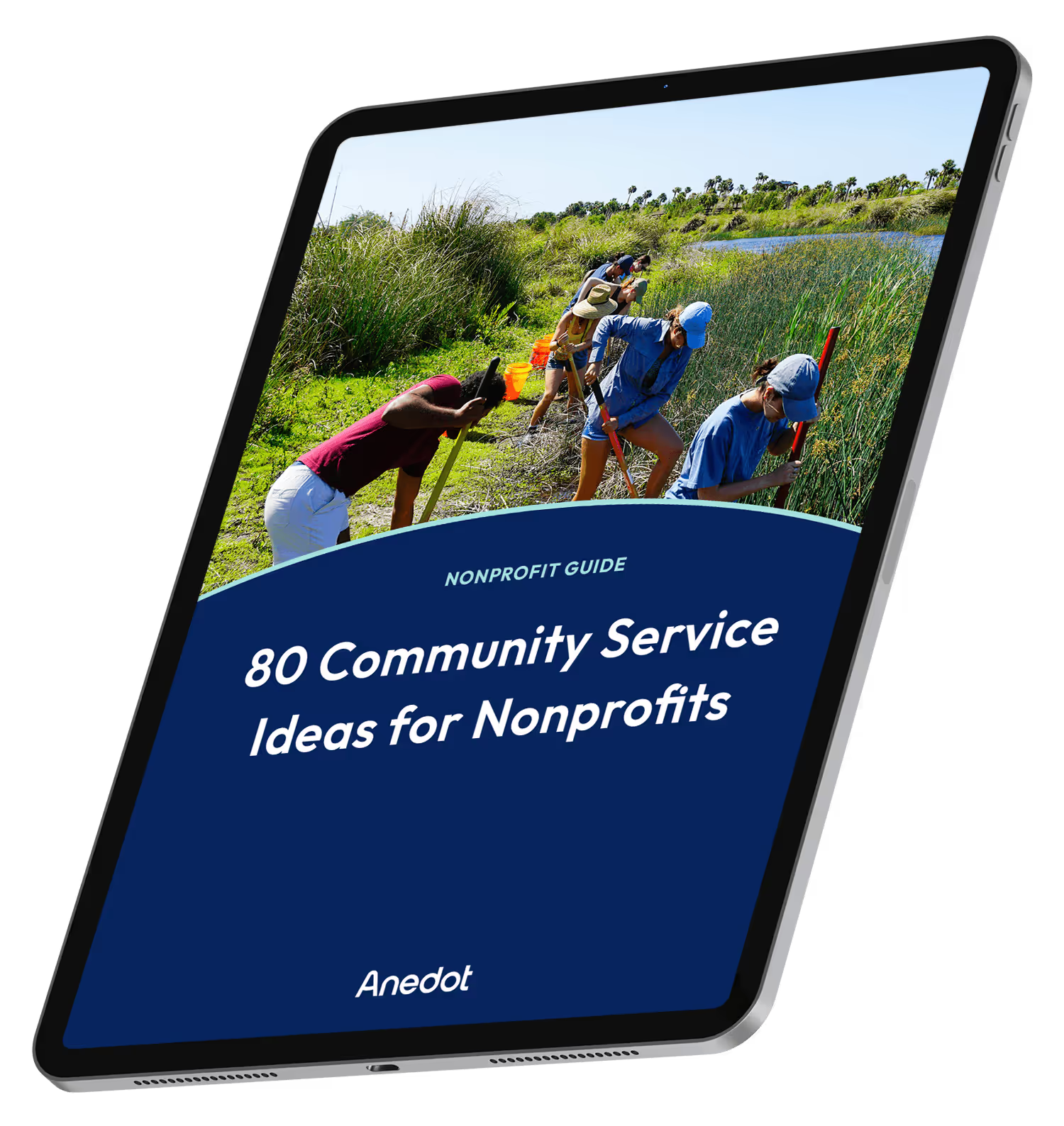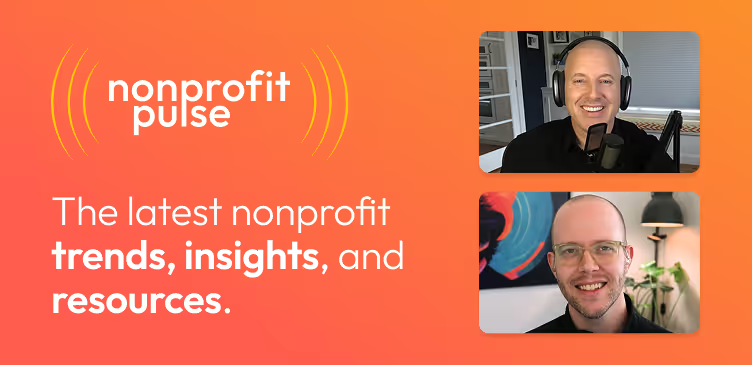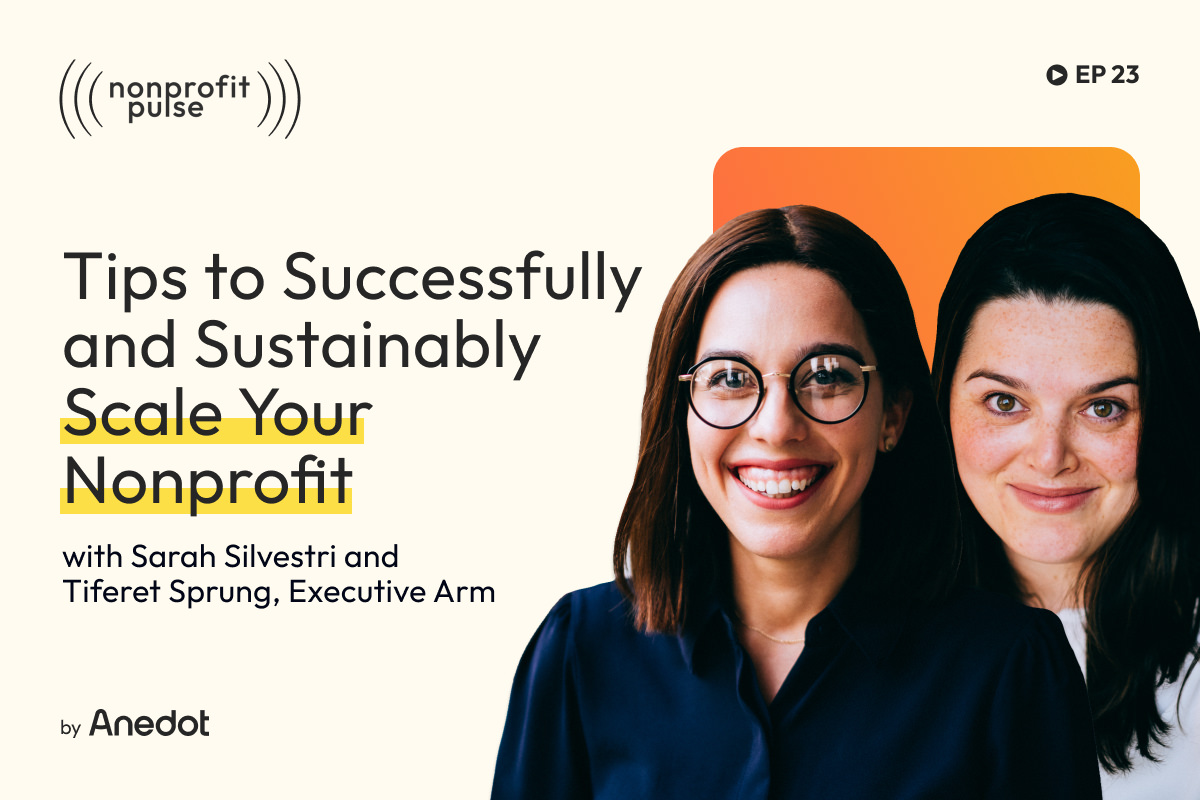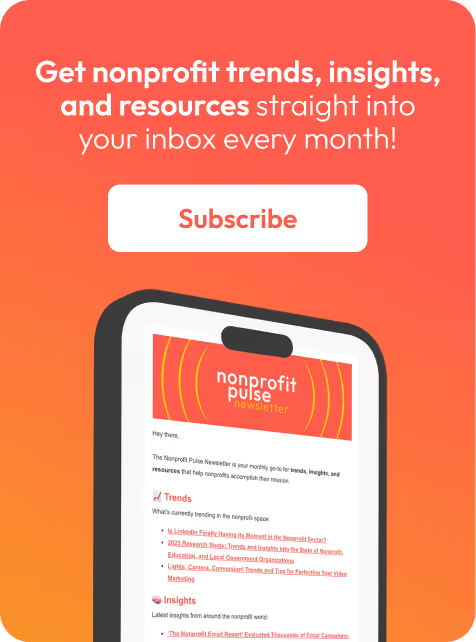Podcast episode transcript ↓
Josh:
Scaling a nonprofit isn’t just about getting bigger. It’s about increasing your impact while remaining aligned with your mission.
So, what key steps should nonprofit leaders follow to scale their organization successfully?
And how can they ensure this growth is sustainable, healthy, and true to their mission?
I’m Josh with Anedot, and welcome to Nonprofit Pulse where we explore trends, insights, and resources that help nonprofits accomplish their mission.
On this episode, we are joined by both Sarah Silvestri and Tiferet Sprung on the topic of how to scale a nonprofit.
As co-founders of Executive Arm, a management outsourcing firm for nonprofits, they help nonprofits achieve greater heights through internal capacity development, executive coaching, and strategic program design.
Hey Sarah, hey Tiferet. Thanks for joining us on Nonprofit Pulse.
Tiferet:
Hey, Josh, thanks for having us.
What is the difference between scaling a nonprofit vs. growing a nonprofit?

Josh:
Yeah, excited for our conversation. Today, we're going to be talking about the art of scaling your nonprofit.
And maybe first, let's just start off by defining terms. And what do you mean by scaling in the context of a nonprofit org?
And really, how is that different from let's say, just general growth?
Tiferet:
Yeah. I think any organization, any nonprofit can grow, but scaling is kind of a delicate balance of do we have the resources?
Do we have the personnel to sustain that growth long term and really, continue the health of the nonprofit in the long term and not just grow?
Sarah:
I think also growth, it's usually connoted with size. And really scaling is about impact.
Whether that's impacting, you know, programing, impacting with your reach, impacting your audience.
And I think that has like a fine line between when you think about like just the natural definition of growth, you just think, oh, it's getting bigger.
But scaling doesn't necessarily mean you're getting larger in numbers, it could just mean you're getting larger in terms of how many people you're touching or servicing.
Or, how many programs you're providing. Or what types, or the quality of programs that you're providing is greater.
So it's like a little bit different than growth.
Lessons from nonprofits that successfully scaled their impact

Josh:
What are some of the key factors that nonprofits should really consider before attempting to scale their operations?
Sarah:
So I think, Tif kind of spoke about this a few seconds ago, but really there's, when you talk about nonprofits, there's, I guess 3 or 4 areas that you're talking about right?
You're talking about organizational capacity, you're talking about financial health, you're talking about your leadership structure, and then you're talking about your effectiveness, whether that's program effectiveness or it's your internal structure effectiveness.
So and what I mean in terms of that, I mean like your org chart, right. Like when you look at your, whether somebody is a CEO or a board of directors, that's, you know, heading your organization.
With nonprofits, those are really the four major areas, or factors that you have to think about when talking about scaling.
Josh:
So thinking about examples, can you share some examples of a nonprofit that successfully scaled its impact, and really what strategies did they pursue in doing so?
Tiferet:
Sure. We worked alongside a nonprofit a year or two ago.
They had a very classic nonprofit start where they kind of fell into it.
They fell into their nonprofit, and then kind of leaned in and they were like, okay, I guess if we're going to do it, let's really do it.
And when we started working with them, they were really, really open in a really beautiful way to do some real soul searching and see, like, does our mission statement still work with what we want to do?
Are we set up for it? What does growth look like? What does scaling look like in a perfect world?
And then we were able to sit down and figure out the strategy that worked best for them.
Because every single nonprofit is different. Every single nonprofit is trying to provide something different and comes to the table with something different.
So those strategies really depend on specifically you and what are you trying to accomplish?
And with this organization, we built out a very extensive strategic plan that kind of, it was like a multi-year plan that was broken down even more like really step by step, like, how were they going to get from where they are to where they want to be?
And because of their ability to really be aware of who they are, I really think if you can be aware of your strengths and weaknesses, you can go further than an equal organization that is theoretically stronger or has different strengths.
If you can really identify, where do we need the support? Where do we excel? And then you can build a strategy around that.
Because they were able to do that, they really were able to take it to the next level in a really impressive way, just simply because they were like, this is who we are, this is where we want to go, and then how can we get there?
Sarah:
I think also, when you're talking about scaling success, right, there are small successes and there are large successes.
And I would say like we work alongside a lot of nonprofits still today. When we first started about four years ago, we have clients have been with us for four years.
I would say some successes in terms of scaling is they had no employees and they had no financial structure, and now they can hire employees and they have a really solid financial structure plan.
Now, that's not a global success in terms of scaling, but in terms of a nonprofit that had one employee and was serving 150 people or 150 family units, and now have four employees and can sustain it, that is a success.
Maybe not in the large scale of nonprofit scaling, but in a small steps of scaling.
How does financial sustainability impact the scaling of a nonprofit?

Josh:
Yeah. And you mentioned different areas of the organization.
And one area I want to lean into is financial sustainability. What role do you all see financial sustainability?
What role does it play in the scaling of a nonprofit? And how can nonprofits really ensure that they're financially ready to scale?
Sarah:
So I think the first thing is really knowing what your capacity is, in terms of being realistic.
Everyone has passions, right? And most people who start nonprofits, they're passionate people who want to do good in the world and want to affect change.
But you also have to be realistic. Everybody and their son has a passion that they want to do, right?
So if you look up nonprofits and you look up a sector of nonprofits, let's take the disability world, for instance, and you're going to find in every area there's probably 4 or 5 different types of nonprofits serving that community of intellectual disabilities.
And sometimes there's overlap in terms of what they're doing, and there's not good functionality in terms of partnership.
So I think in order to ensure financial sustainability, the first step is really figuring out what your mission is.
And are there partners surrounding you that can be part of your mission? And maybe what your original mission was is not what your mission needs to be, right?
So, that's really step one, really. Like, do you have a function?
Is your nonprofit really something that is affecting change in the best way possible? And are you utilizing your resources in terms of partnerships?
In 2024, what we're seeing across the board is, in terms of financial sustainability of nonprofits, it's really difficult, right?
People are stretched thin and they want to support you and they want to financially support you, but they may not necessarily have those elevated means to support you.
The first step is really finding avenues where you can ensure through partnerships that that sustainability is not only through one direction. It's through multiple directions in order to expand that aspect.
And the second thing is really having a fundraising and development plan in place.
I say that because every nonprofit we work with and I can't stress this enough, they have a development plan.
And what does that mean? Like, okay, we'll have a fundraising gala in the springtime and we'll have maybe a crowdfunding campaign or mailing at the beginning of the year.
But there actually isn’t steps of what that looks like, who's going to execute the plan, and what is it going to cost you?
Because there's always upfront costs. Even if you're doing a crowdfunding campaign, there are costs upfront, right?
Marketing, PR, do you have the personnel to do that? Is your board or whoever your leaders in your nonprofit, your volunteer leaders behind what you're doing.
Because if you don't have any of that in place, you can have whatever development plan you think you have.
But actually, in reality, it's nonexistent.
Tiferet:
Yeah, I think that really hits the nail on the head of kind of what we're seeing across the board.
I also think, a lot of times people come to us and they say, you know, last year we brought in an extra X, and with that X we want to scale. And that’s beautiful.
That's great. And like, congratulations because so many nonprofits are not bringing in enough to keep themselves afloat.
So coming in with extra is like you're ahead of the game, but you're only ahead of the game for right now. You need to know, how are you going to continue?
Let's say that was an extra $75,000, and you want to use that $75,000 to hire someone.
You have to be really strategic about how you're going to ensure that you still have that $75,000 at the end of the year to pay them again a second year.
And one thing that we often say, as Sarah’s saying is if you have a development plan in place, then you can kind of set yourself up for success.
If you say, okay, the first person we're going to hire is going to be a development person so that we can make sure that we use the $75,000 for future growth.
You might have a need for other staff members, but if you start with whatever it is that your team is lacking, you're much more likely to come out with a sustainable plan.
Instead of a plan going we can't pay the salary two years in a row. We didn't realize we were only going to come out on top because during the pandemic there was a lot of giving.
And then after the pandemic, it kind of waned. And there's a bit of a financial issue at large right now. And people aren't giving right now.
We're seeing a lot of nonprofits struggling to get the numbers that they're used to getting.
So if you have a really healthy plan in place that doesn't kind of put you paycheck to paycheck, if you think about your own finances, you don't want to buy a house that you can pay for right now.
You want to buy a house that you're going to be able to pay for for ten years.
So it's the same thing when you're putting together a strategic plan. Is this a plan that we can sustain long term?
And how can we ensure that if we don't hit our numbers next year, that we're not going to have to take a step back?
Josh:
Yeah. And how do you all see, part time versus full time employees playing into that?
You know, and there's a lot of thoughts around, productivity of part time versus full time and especially a nonprofit, are they really committed? You know, there's just concerns there.
But any thoughts on that? Regarding sustainability and hiring and pursuing multiple part time versus, maybe that one full time larger role?
Tiferet:
Yeah. I think that there is a really big fear among nonprofit leaders. They, as Sarah said, they have this huge passion.
I'm going to change the world by getting the best education into the public school systems in my area, whatever it is, right?
And they feel so passionately about this, and they have this fear that if they hire someone that doesn't have the exact level of passion for the exact mission statement that they're somehow going to fail.
The beauty of you is that you have that passion more than other people, which is why you're starting the nonprofit about it.
So I think it's okay if you don't have an employee, you want to have employees that are mission aligned, and you want to have employees that are passionate about helping people because that's at the end of the day, what you're doing.
But if you are, if you kind of box yourself into a corner of saying, I'm only going to hire somebody who's going to blood, sweat, and tears this with me, you're going to have the problem that a lot of nonprofits have, which is burnout.
Which is you hire somebody to do one job, but really you're expecting them to do six jobs.
And at the end of the day, they're putting their computer down at 8 p.m. and they're just they're going to burnout within a few years.
If you can allow yourself to say, okay, that would be a perfect world. If I could find somebody that is so dedicated alongside me.
But I'm probably not going to find that. What I really need to find is someone with the right skills and then decide, is that person going to be full time?
Is that person going to be part time? I don't think it makes a huge difference to the success of the company if you can find the right fit.
It doesn't have to be someone who's willing to give you 100 hours a week. It probably shouldn't be someone who's going to give you 100 hours a week.
How to scale a nonprofit without losing your mission and values

Josh:
Yeah, that's a great segue Tif into the next question, which is, one of the concerns with scaling that nonprofits have is, oh, we're going to lose our identity, right?
We're going to lose our mission. Our mission is going to get watered down as we do more things, as we're distracted about different areas of opportunity.
We're not going to be able to really control our values and make sure that they permeate through everything we do through our employees through our communications, etc.
What would you say are some of the common pitfalls or challenges related to that? And really, how can nonprofits stay true to their mission and values while at the same time scaling their organization?
Sarah:
I mean, I think in reality, we kind of touched on it, but Tif mentioned, you can't really have the same expectations for your employees, that you, the passion behind the nonprofit, right, has.
You have to be realistic, but you also have to set a stage where you know, your employees have the independence, and the resources to be mission driven.
Just because someone doesn't necessarily have the same vigor as you have in terms of what you're doing for your nonprofit, doesn't mean they can't be effective.
And let me give you an example. In terms of like, data, right?
Everyone knows the worst part of every nonprofit is making sure your data is the best that it can be, so that when you're reaching out to potential donors or you're developing relationships, you have the proper information at your fingertips.
And when you're sending out mailings, you're addressing it properly. That is a tedious job.
And just because the person doing your data doesn't have the same passion as you, doesn't mean that they're not the right skilled person.
Maybe it's a part time person. Maybe it's a full time person. I think that's really dependent on balancing your needs.
I think a common pitfall with scaling is just the inability to see other people's strengths and utilizing their strengths versus you putting what you feel is the strength on everybody else.
So I think it's really a lot of self reflection. And I say this because it's probably one of the hardest things as humans to do.
Right? In life, when you're asked to self-reflect and you have a situation that doesn't go the way you want to go, most people, it's really hard to say, what did I do wrong? Where am I in this scenario?
And I think with nonprofits, with all leaders of nonprofits, whether you started it or you're now sitting on a board of a nonprofit, sometimes you have to say to yourself, am I the right person sitting in the seat?
Maybe I was two years ago when I got this position, but now I don't think I have the skill or I don't have the same abilities, and taking yourself out of that, or shifting roles and responsibilities and reassessing is so important.
And to do a lot of that self-reflection takes a lot of drive and time, and that's something that lots of nonprofits don't really spend enough time doing.
Tiferet:
Yeah, I think, when it comes to scaling and staying mission aligned, a lot of times it's so easy for a nonprofit leader to get so excited about an initiative.
And especially if you're one of the amazing nonprofit leaders that really allows your team to present ideas and present new suggestions, it's so easy to get excited and go down the next pathway.
If you can kind of allow yourself to hear the feedback from other people and create an environment that encourages it, you can kind of prevent that, oh my goodness, we just spent two years going down something and this did not, this was not mission aligned.
It helped a lot of people, but it took us away from our original mission and therefore did not serve the organization.
Creating a team environment that is conducive for people to be able to say, is this mission aligned and having intentional kind of reviews of this is what we're doing.
If you set in like a quarterly or five minutes at the end of every monthly meeting, whatever it is, if you set in that time to go, this is what we're doing and this is how it is mission aligned.
If you force yourself just to address how everything is mission aligned instead of asking, is it? Let me word for you how this is mission aligned.
You're really going to see that you can put all of your energy and you have all that beautiful energy, and you have all of the involved staff members.
You can funnel all of that towards your mission instead of the passionate person getting passionate about something that's maybe going in a direction that wasn't so successful and wasn't so helpful towards what you all started out doing.
Josh:
I love that, and I love the idea of intentionality, of always keeping your mission and your values in front of your people.
And it reminds me of something that I've been thinking about recently, as I've been leading my team and that is see something, say something, right?
Like we are all able to see and say whatever we need to at any point to say, hey, this decision over here, I don't disagree with it necessarily, but it does seem to not be in alignment with our values or our mission.
I think empowering people to do that is how nonprofits can effectively protect, as they scale, but protect their mission, protect their values, which ultimately, doesn't just impact the internal operations of the nonprofit, but it affects donors, it impacts donors and fundraising and overall brand and all of those things.
So, yeah, just super important to really lean into communication around are we being the people and the organization that we want to be.
And we've said we will be. I think that's huge.
Tiferet:
Yeah. You'd be surprised how many times we're brought on to a project. And we have an initial meeting with a person within the nonprofit, and they explain the project.
And then we have another meeting, and we always start the second meeting with, okay, I already spoke to Josh. Now, I'd love to hear from Sarah. And it's like a completely different scope.
And so sometimes just having that conversation and making sure everybody's on the same page, and it's to nobody's fault.
It's just everyone's excited. And sometimes just kind of getting that more streamlined can be more successful even if it means you have to compromise a little bit sometimes.
Sarah:
Yeah. I also think it's okay sometimes for nonprofits to have the permission to say this is not what we do.
And I think that's really hard for people who are passionate and people in the nonprofit sector.
Yeah, you want to give you want to help everybody.
And when someone comes to you with a problem and you want to solve it and in your mind you're like, this is actually not something I can do or is not aligned, but I just want to solve it.
Sometimes we get lost in that translation.
Josh:
Yeah. When I think about situations like that, it makes me think of that's why having a network is so important to that, that you can hand them off to a partner organization or a friend’s organization to say, you know, we don't do that particular thing.
We don't serve that particular audience. However, I know someone who does let me get you in contact with them.
And I've just been encouraged having conversations on this podcast over the past year, year and a half, with just a goodwill that's inside of the nonprofit community, of wanting that impact at a local level, you know, regional or even national level, that there's just a lot of opportunity to still help people, even if you specifically and your organization doesn't do that.
Tiferet:
And there's also a beauty in that hand off for a number of reasons.
First of all, if I kind of derail myself, I'm not really able to focus on my mission. But not only am I not able to focus on my mission, I might not be the person.
I don't have the resources to help them in the capacity they need help, whereas if I just hand them over to nonprofit B, that's what they're set up for.
That's their strong point. And we can kind of, as Sarah was talking about partnerships before, we can partner.
And sometimes you see long term partnerships come out of this, right?
If nonprofit A is constantly getting a certain request and funneling off to nonprofit B, sometimes they can come together and go, I think we can create a joint initiative because there's a lot of overlap here, and you can create something bigger.
Instead of saying, I'm going to frazzle myself and I'm going to help you, even though it's not really what I do.
There's strength in the ability to say, that's not what I do, but that is what's something that they do. And it can allow you to scale because it allows you to focus on what you're trying to do.
What should nonprofit leaders prioritize in leadership and internal capacity as they scale their organizations?

Josh:
So, thinking about internal capacity, we talked about it earlier a bit, but thinking of leadership and internal capacity.
What should nonprofit leaders focus on as they scale their organizations in regards to leadership and internal capacity?
Tiferet:
I think a big thing that leaders can focus on, the first thing they can focus on, after they've done an internal analysis of their strengths and where they need to grow.
The first thing they can work on is their staff and professional development.
Sarah touched on this a little bit before, but we see a lot of the time, one of two things.
Either a staff member who is simply doing the wrong job, like a staff member who is a graphic designer, who's doing the bookkeeping and it's like, but you need a graphic designer.
Why did you hire that graphic designer? Why are you telling me you need to hire a graphic designer when you have one?
And why are you saying you have a bookkeeper when you have a graphic designer, right?
Like, a lot of times it's like when I hired you, I didn't need a graphic designer, so I stuck you in the bookkeeping role. But now I need a graphic designer.
So let's let you fly. Like, let that person fly.
That's a huge thing we see is when nonprofits are small, they're kind of looking for a catch all role. And then the roles get all jumbled.
So when they're ready to really scale, kind of look at the staff, don't be so tied to what your staff is currently doing.
Think about what you need and what you have, and you might have to restructure. And that is going to allow your staff to kind of bloom in a way you haven't seen, which is a really nice thing to see.
And then another thing that we see sometimes is people having simply no faith in their team, which I can't account for it. I don't know why they're on your team if you have no faith in them.
Like we need to start with that.
If you as a leader, feel the need to micromanage everything because you don't have the faith in them, you're never going to be able to scale. You need to have a team that you can rely on, and a team that you can have faith in.
And if that means getting them some professional development, some training in the area, or seeing if there is a way to restructure them into something, or maybe it's work you need to do on yourself, saying, I know that I'm the one with the passion, but I really believe that this person can do what I hired them to do.
So I'm going to step back and let them do it. These are some huge pitfalls that we see, and it really comes from a good place, right?
It all comes from just natural desire for everything to be perfect, but it can create a lot of redundancy and a lot of lagging for lack of a better term.
Practical steps to begin scaling your nonprofit

Josh:
So thinking about our audience and thinking about those, maybe the smaller nonprofits looking to scale, what would you say are some practical first steps that they can take to really begin that process in earnest and also successfully?
Sarah:
Well, I think the first step is really assessing yourself financially to see what your abilities are, because if you want to scale in terms of expanding your leadership or expanding your staff or even expanding your programing, that takes dollars and cents.
And, that's the reality of the world, right? It takes money to grow or scale and really making sure that what your mission is actually has a purpose and that you're not reproducing what someone else is doing.
I know that sounds a little, you know, innocuous and scary, but I feel like there are so many times where I hear, oh, this person is doing this.
And I'm like, doesn't that person down the street do the same thing? And the answer is, yeah, but in a different community or yeah, but they help females and this one helps males.
I'm kind of like, well, why can't we do it together? Or why can't we change our mission to do something that really is needed that's not being addressed?
So I think really there's a financial aspect to it and making sure your mission is actually something that's needed.
Tiferet:
Yeah. I think that, yeah, making sure that your mission is needed. And sometimes there can be redundancy.
Sometimes there can be nonprofits that serve the same thing. But you can partner with someone who's already doing something and have a bigger impact.
So sometimes scaling could be merging with somebody else.
We've actually seen that successfully done time and time again, where they suddenly have access to bigger resources because a similar nonprofit already exists.
So now you become a wing off of it.
Also, what we were talking about a little bit before, like really having that self-reflection because I can't tell a blanket thing, a route to scaling because every single nonprofit is different, every single staffing structure for the nonprofit is different.
What they're trying to do is different, and how they're going about it is different.
But if you can take a step back and have a bird's eye view of your nonprofit and see where there might be like chinks in the armor, before you get to scaling, you have to get your house completely in order.
You have to have the perfect like, make sure your team is really cohesive. Make sure your finances are really in order, and then you have to make a plan.
Where am I trying to go? And you want to work backwards from there. And don't have a “where am I trying to go” this huge thing?
If you're currently in your dorm room creating the next nonprofit to solve world hunger, do not have your “where I'm trying to go” as world hunger is gone. That's beautiful. That’s a 50 year plan.
Maybe that's not in our three years scaling plan. If you can have a realistic where I want to go within the next three years, I wouldn't make it longer than that and then work backwards.
How can I get there? What are the things I need to get there? What do I have today? And this could take a very long time.
This could take days of really doing some introspection, looking at your numbers, your books, looking at who the resources you have and resources is not always financial, right?
If you have a board member or if you're not big enough to have a board member, but you have a volunteer that's really passionate about something, that's a resource.
You look at the resources you have, you look at where you want to go, and you build it out in small increments of how can I get there?
And I always say to work backwards, because that's the most logical way to get there.
You're going to build yourself a roadmap of how to get from where you are to where you're trying to go, and if you can allow yourself to deviate from that plan, because that plan looks beautiful on paper, but it's almost certainly not going to happen that way.
If you can build yourself a plan and allow yourself the grace to deviate when needed, you really can do phenomenal things. But you have to be intentional about it. You can't just say, I have a little bit of extra money and so now I'm going to scale. There's no obvious next step. You have to figure out where your specific next step is.
And anybody that tells you there is a first step doesn't understand the nuances of how every single nonprofit is different.
Closing thoughts

Josh:
I love that, and just that's a good segue into resources.
So any resources that y'all would recommend to our audience on the art of scaling a nonprofit?
Sarah:
Yeah, I mean, there are a few great books.
One is called Lean Impact by Ann Chang. And it really talks about nonprofit financing and really what to lean into in terms of your nonprofit.
There is a ton of webinars out there, and I know that sounds crazy, but, I feel like the one beautiful thing about Covid is that it really taught people to be resourceful on the internet and remotely.
And there are so many communities you can join online.
I know webinars usually you don't think that could be your community, but there are so many nonprofit leaders that are presenting different topics.
Whether you feel like you need help in financing, whether you want a different perspective in terms of scaling, whether you want to talk about pitfalls and what someone experienced, whether you want to hear somebody’s experience of how they grew a nonprofit or how they failed.
And honestly, sometimes the failures are where you learn the most. And there's so many online webinar resources and communities and social networking.
I mean, it is so important, like you said, to have a network of people that you can throw ideas at and someone can say to you, that is not a good idea. And I'll tell you why. Because I tried it.
And here's what worked and what didn't work. Or that sounds great, but what about X, Y, and Z?
Did you think about these elements? Did you think about how it's going to affect you in the grand scheme.
Did you think about your staff. Like somebody really who you trust, that can give you some great advice that isn't as internally connected to what you're doing.
Tiferet:
One thing I think that happens sometimes is the nonprofit world thinks of itself as an island.
Both in a micro sense, where each nonprofit thinks of themself as an island, where as Sarah said, there's communities and it's not your competition.
Have that conversation with other nonprofit leaders and again, you can be the smallest nonprofit and have something impactful to say to another nonprofit leader that can really help them because you've tried something, they haven't tried it yet, and you can learn from each other.
So there's that in the micro sense, the island.
But also, I think a big mistake that people make is viewing nonprofit as completely separate from the business world, and it's simply not.
Nonprofit, the goal at the end of the day might be different, but creating a sustainable nonprofit is very similar to creating a sustainable business.
And so if you lean into those resources, reading books on business, listening to podcasts on business, you will gain insight like you can't even believe.
Especially since a lot of times the best nonprofit leaders are not necessarily the math minds and the finance minds.
And so kind of leaning into that and getting an eye into that world can really give you a leg up into how you can best scale and how you can look at your finances in a different way and how you can leverage things.
And that can be so helpful. So just remembering that there's tons of resources for nonprofits, but there's also tons of resources for business.
And they're very similar. And there's so much overlap.
Josh:
Yeah, I love that. It just makes me think of, one of my favorite business books, The Five Dysfunctions of a Team by Patrick Lencioni.
And just how applicable it is for nonprofits, too. I mean, we're all the same people, right?
We're just working in different contexts. But we have the same dysfunctions, the same challenges, the same ditches that we fall into as we navigate relationships and team and all those things.
So, yeah, thanks for sharing that.
So, for our audience, you can check out the show notes at Nonprofitpulse.com to find these resources, as well as others.
And then last question, Sarah and Tif, my favorite question of every episode.
If you were standing on stage in front of a thousand nonprofit leaders and could share one thing with them, one sentence about this topic, what would you say?
Tiferet:
Can we each have one?
Josh:
Sure, absolutely.
Tiferet:
I think it's a little bit of an unpopular idea, but have the confidence to invest in your overhead more than your donors want you to.
Just because a lot of times people want the leanest overhead to have the biggest impact, but you can have a much bigger reach and a much more sustainable lifetime as a nonprofit if you really have your overhead structure perfect.
Sarah:
Yeah. I would say the most powerful scaling strategy is really grounding yourself in your mission and your core values and not deviating from it, even when your largest donor or your biggest leader says we want to go a different direction.
And that's so difficult. But I would say if you can wade through the tough waters, there is another side.
There's strength on the other side.
Josh:
Love that. And just thinking about our audience, and I hope this episode really encourages them to at least pick up the conversation. Right?
Start thinking about should we be scaling our organization?
I mean, there's thousands, if not millions of nonprofits out there who are considering this or should be considering this.
I hope this episode is an encouragement to them. And, like I said, it gets the conversation started.
Sarah:
Thank you so much for having us. Such a pleasure.
Tiferet:
Thank you. This was really interesting.
Josh:
Hey, thanks for listening.
If you enjoyed this conversation, please share or leave us a rating and review wherever you listen to podcasts.
Also, head on over to Nonprofitpulse.com to sign up for our monthly newsletter, as well as check out all the links and resources in the show notes. We’ll see you next time.

80 Community Service Ideas for Nonprofits


























